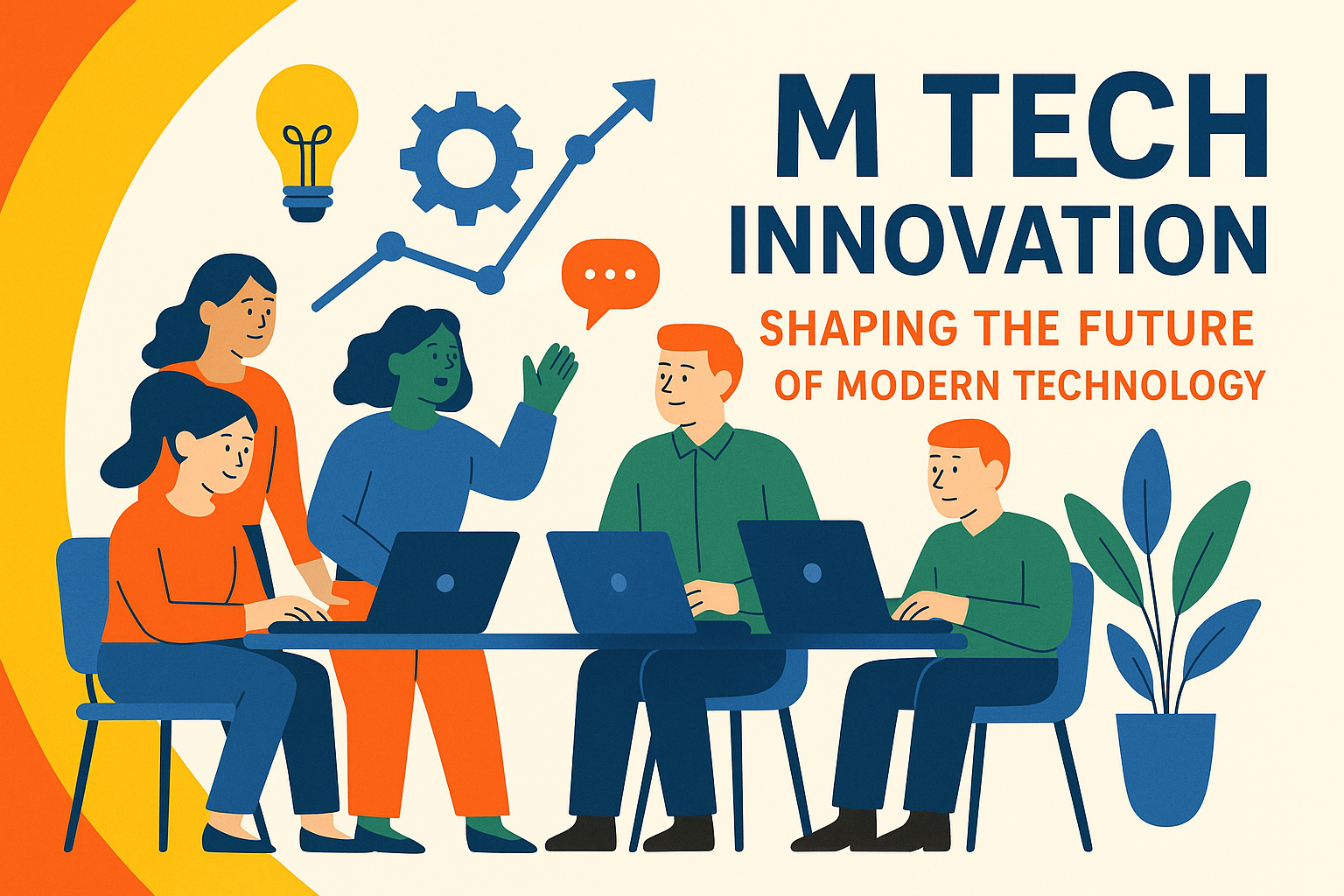Table of Contents
The Real Meaning Behind M Tech Innovation
When people hear the term m tech innovation, most imagine robots, flying cars, or some sci-fi version of the future. But in reality, m tech innovation is far more grounded—and perhaps more powerful. It is about how modern technology is being reshaped through research-driven engineering, industrial collaboration, and deep academic insight.
As someone who has followed the tech space for over a decade, I’ve watched closely as m tech innovation transitioned from being a mere academic pursuit to a powerful industry driver. The transformations are happening not just in big cities or elite universities, but even in remote corners of India where research labs are lighting up with ideas that solve real-world problems.
This article explores the world of m tech innovation—from its academic roots to its industry impact—based on research, expert opinions, and my own commentary on what truly matters.
What is M Tech Innovation Really About?
At its core, m tech innovation is the evolution of postgraduate engineering (Master of Technology) studies that combine theory with problem-solving applications. Unlike B.Tech programs that offer broader engineering exposure, M.Tech allows deep specialization.
M Tech innovation comes into play when students, researchers, and professionals don’t just stop at learning—they go a step further to create. Whether it’s building advanced automation systems, developing efficient data compression models, or designing energy-saving machinery, it’s all part of this innovation ecosystem.
For example, at institutions like IITs, NITs, and even state universities, students working under professors develop real patents, publish international papers, and even commercialize their innovations through startup incubators.
I personally remember attending a project demo at an M Tech seminar in Bangalore where students created a prototype for low-cost, AI-based soil moisture sensors. That simple idea ended up being adopted by a local agri-startup—something that may not have been possible without this innovation-driven environment.
The Journey: From Classroom to Real-World Applications
Most people assume M.Tech is just a two-year academic commitment. But m tech innovation is not just about books and exams. It’s a structured journey where students take up internships, collaborate with industries, work on live projects, and often pursue research-based dissertations.
Let me give you a real example.
Case Study: Smart Traffic Signal System – NIT Trichy
A group of M.Tech students from NIT Trichy worked on a smart traffic management system powered by real-time data and AI algorithms. The innovation was simple: adjust signal timings based on traffic flow using sensors and edge computing.
What started as a semester project caught the attention of the Tamil Nadu Municipal Corporation. Within a year, their prototype was implemented as a pilot in two city junctions—drastically reducing congestion during peak hours.
This is the kind of outcome that makes m tech innovation so powerful—it transitions knowledge into impact.
Academic Research + Industry = Innovation Ecosystem
One of the major forces driving m tech innovation is the growing partnership between academic institutions and industries. Earlier, there was a significant gap between what students studied and what companies expected. That’s rapidly changing.
Now, industries like Bosch, TCS, DRDO, BHEL, and Infosys frequently partner with M.Tech programs to fund research, offer internships, and even co-develop products.
At IIT Madras, a batch of M.Tech students in Electrical Engineering co-developed an IoT-based motor diagnostic tool in partnership with ABB. This tool is now being tested in industrial plants across South India.
From my own interactions with a few of these students, what stood out was the balance of classroom learning with field exposure. One of them told me, “We didn’t just code—we went into factories, saw motors malfunctioning in real-time, and tested our product hands-on.”
That is the magic of m tech innovation: it isn’t theoretical. It’s alive.
Entrepreneurship: When M Tech Innovation Turns Into Startups
Another exciting trend is the rise of student-led startups fueled by M Tech innovation. Institutes are now setting up Technology Business Incubators (TBIs), offering seed funding, mentorship, and even co-working space for promising innovations.
Example: FlytBase – Born Out of M Tech Dreams
FlytBase is a Pune-based startup that creates drone software platforms. What many don’t know is that it was born from an M.Tech research project. Today, FlytBase is used globally by drone automation companies.
Their founder, an M.Tech graduate from IIT Bombay, often credits the university’s incubation support for the launch of the product.
And this isn’t an isolated case. From health tech to ed-tech, M.Tech students are venturing into entrepreneurship with strong technical foundations.
Even at local state colleges, I’ve seen students turning final-year thesis work into prototype applications—like an affordable hearing-aid model from a government engineering college in Assam that is now under clinical testing.
M Tech Innovation in India vs. Global Trends
Now, let’s step back and ask—how does m tech innovation in India compare with what’s happening globally?
Countries like the USA, Germany, Japan, and South Korea have long established traditions of integrating research with industrial production. But India is catching up fast. Programs like the Prime Minister’s Research Fellowship (PMRF), Make in India, and Startup India are pushing young researchers to think beyond grades.
One impressive example is the collaboration between Indian M.Tech researchers and international labs. A team from IISc Bengaluru worked with MIT Media Lab on low-power processor design, and the outcome was a research paper that’s now influencing global processor architecture.
From what I’ve seen, Indian M.Tech talent is no less capable—often even more adaptable. The challenge lies in exposure, funding, and infrastructure, which are now being addressed aggressively.
M Tech innovation is now a buzzword not just in top IITs but also in tier-2 and tier-3 institutions. That’s progress worth celebrating.
M Tech Innovation in Key Technology Domains
If you look at the most groundbreaking shifts in modern technology—Artificial Intelligence, Robotics, Green Energy, Embedded Systems, or Biomedical Devices—you’ll find m tech innovation quietly powering them in the background.
Let’s look at some key areas where M Tech students and researchers are making significant contributions:
1. Artificial Intelligence and Machine Learning
AI is perhaps the hottest field today, and many M.Tech Computer Science programs have specialized tracks in AI/ML. These programs go beyond what undergraduates learn, diving deep into neural networks, reinforcement learning, and NLP (Natural Language Processing).
At IIT Hyderabad, for instance, M.Tech students created a deep-learning-based facial recognition model optimized for low-light environments—ideal for surveillance in rural or low-electricity areas. This model outperformed some commercial offerings, according to peer-reviewed benchmarks.
From my interaction with a few students from that batch, they didn’t just learn the math—they were solving real issues like rural safety and accessibility. That’s the difference m tech innovation makes—it has purpose.
2. Robotics and Automation
Many industries, especially in manufacturing and defense, are undergoing robotic transformation. M Tech Mechanical and Electronics departments across India are pushing forward with automated systems—robotic arms, drones, and human-assist devices.
A group at NIT Rourkela recently developed a robotic glove for Parkinson’s patients to reduce hand tremors. Their prototype gained national attention and funding from the Department of Science & Technology.
It’s one of those innovations that originated in a classroom, backed by professors, improved through field testing, and is now getting closer to full-scale deployment. M tech innovation is giving real hope to people—not just making machines smarter.
3. Green and Sustainable Energy
With climate change a growing concern, many M Tech projects are pivoting toward renewable energy—solar, wind, biomass, and efficient energy storage systems.
Students at Anna University developed a low-cost solar inverter using IoT sensors that monitor efficiency in real time. Their innovation is now used in a village solar electrification project in Tamil Nadu.
Their approach? Simple. They didn’t try to reinvent the wheel—they just improved it. And in many ways, that’s what m tech innovation is about: making existing systems smarter, affordable, and accessible.
A Word From the Field: Real Experiences from M Tech Innovators
To give you a more human perspective, I reached out to a few M.Tech graduates and current students and asked them how their journey with m tech innovation has shaped their thinking.
Interview 1: Rajeev, M.Tech in Electrical Engineering (IIT Kharagpur)
“During my M Tech, we weren’t just working on theory. Our professor pushed us to file patents, not just assignments. My research on energy optimization algorithms is now part of a pilot by the state electricity board. That’s something I didn’t think possible as a student.”
Interview 2: Shalini, M.Tech in Biomedical Engineering (Manipal University)
“I co-developed a sensor-based wearable to monitor blood glucose levels non-invasively. We got grant funding to test it on diabetic patients. It wasn’t perfect, but the feedback we got from real users was worth every late night we spent in the lab.”
These aren’t superstar success stories hyped by the media. They’re the daily grind of m tech innovation—quiet revolutions happening in academic corridors.
The Role of Faculty and Mentors in M Tech Innovation
Often overlooked, professors and guides play a crucial role in nurturing m tech innovation. The best M.Tech programs are ones where faculty act less like examiners and more like co-researchers.
At IISc Bangalore, professors frequently co-author papers with M.Tech students and push them toward international exposure. I once sat in on a seminar where a faculty member said something that stuck with me:
“We don’t train students to find jobs—we train them to find problems worth solving.”
That mindset shift is what sets m tech innovation apart. It’s not about chasing grades; it’s about chasing impact.
Challenges That Still Exist in M Tech Innovation
Despite all its potential, m tech innovation in India is not without hurdles. Here are a few real issues many students face:
- Limited access to funding: While elite colleges get grants, students in smaller institutions struggle to fund projects beyond prototypes.
- Industry hesitation: Many companies are hesitant to trust student-led innovations for deployment at scale.
- Lack of lab infrastructure: Not every M.Tech college has well-equipped labs or research-friendly environments.
- Academic pressure: Sometimes innovation gets buried under coursework, exams, and grade-focused culture.
That said, change is happening. Government schemes like IMPRINT, SERB, and Atal Innovation Mission are actively funding grassroots M Tech projects.
More importantly, as student awareness grows and entrepreneurship ecosystems mature, M Tech students now have more reasons to innovate than ever before.
What Lies Ahead: The Future of M Tech Innovation in India

Let’s look at the road ahead. As India moves into a more tech-driven economy, m tech innovation will play a defining role in sectors like:
- Smart cities
- Space tech
- Defense technology
- Precision agriculture
- AI-based health diagnostics
The launch of National Research Foundation (NRF) with a Rs. 50,000+ crore allocation by the Indian government is a major step in promoting high-quality research, much of which will originate from M.Tech and Ph.D. students.
Another big boost is international collaboration. Indian M Tech scholars are now getting exchange opportunities with universities in the USA, UK, and Japan—exposing them to global innovation standards.
In my opinion, the next wave of unicorn startups, deep-tech companies, and national-level R&D projects will not come from Silicon Valley—they’ll come from India’s M Tech labs.
Case Study: M Tech Innovation Powering the Startup Boom
Let’s talk about a real transformation.
Ather Energy, the electric scooter company you’ve probably seen advertised everywhere, was started by two M Tech graduates from IIT Madras. What began as a research project in the campus incubation cell eventually raised millions in funding and built one of India’s fastest-growing EV brands.
What made this possible? Access to labs, mentorship, and belief in research-led product development.
This is the epitome of m tech innovation—when education turns into enterprise, and knowledge becomes power. Whether it’s renewable energy, AI, or sustainable infrastructure, the wave of innovation coming out of M Tech labs is rewriting what Indian startups can achieve.
In my conversations with some young founders, many admitted that their startup ideas weren’t born in co-working cafes but in research labs, where they had access to tools and advisors. M Tech gave them the technical foundation—and the courage—to turn ideas into prototypes, and prototypes into products.
How Colleges Can Nurture M Tech Innovation Further
Despite the positive growth, there are ways institutions can better support m tech innovation. Here are five practical suggestions based on feedback from students, alumni, and industry mentors:
- Encourage patent filing – Colleges should actively help students patent their innovations. Government schemes offer subsidies for this, but many students are unaware.
- Expand industry collaboration – Bringing in live problem statements from companies allows students to work on real-time challenges with potential commercial value.
- Offer innovation credits – Just like academic credits, innovation credits can be awarded for successful projects, research papers, or MVPs.
- Upgrade lab access – Many brilliant ideas never leave paper because the institution lacks modern tools. Shared maker labs can fix this.
- Celebrate student-led innovation publicly – College websites, social media, and local press should spotlight successful M Tech projects. Recognition inspires more innovation.
Frequently Asked Questions (FAQs)
1. What is m tech innovation?
M tech innovation refers to the application of research-based knowledge in Master of Technology (M.Tech) programs to create practical solutions, technological products, or impactful studies that benefit industries and society.
2. Is M Tech useful for starting a startup?
Yes. Many successful Indian startups like Ather Energy, GreyOrange, and Detect Technologies began as M Tech research projects. The technical depth and access to academic resources often give founders a unique edge.
3. How is m tech innovation different from regular engineering projects?
Unlike undergraduate projects, M Tech innovation involves deeper research, greater industry collaboration, and often includes publishing papers, filing patents, or building deployable products.
4. Which colleges are best known for m tech innovation in India?
Top IITs (like Madras, Bombay, and Delhi), NITs (like Trichy and Rourkela), and institutions like IISc Bangalore are widely recognized. However, several state-level universities are also doing groundbreaking work.
5. What are the career options after engaging in m tech innovation?
Graduates can pursue roles in R&D, product development, AI/ML engineering, robotics, or even launch their own startups. Many also go on to pursue PhDs or research positions globally.
Why M Tech Innovation Deserves More Attention
Let’s be honest—engineering education often gets criticized in India for being outdated or too theoretical. But m tech innovation is proving otherwise. It’s creating a silent but powerful movement—students and researchers building things that matter.
From solving urban traffic issues to powering rural homes with clean energy, from developing medical diagnostics to reshaping agriculture with AI—M Tech is no longer a second choice. It’s becoming the first step toward real innovation.
In my experience, if there’s one takeaway from all the stories, interviews, and research—it’s this:
Innovation doesn’t need a Silicon Valley address. Sometimes, it just needs a curious M Tech student, a professor who believes in them, and a lab that stays open late.
Let’s hope more colleges, governments, and industries realize this and invest deeper into India’s M Tech potential.
Because the future? It’s already being engineered in these labs.




Leave a Reply